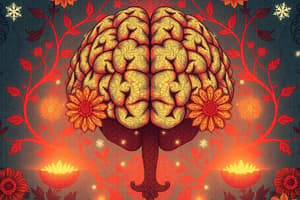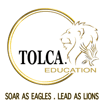Podcast
Questions and Answers
What can leaders do to promote learning, growth, and innovation?
What can leaders do to promote learning, growth, and innovation?
- Promote emotional regulation among competitors
- Provide opportunities for habit loops
- Teach employees the AGES model
- Encourage employees to take breaks and space out their learning (correct)
What is the purpose of understanding neuroscience in decision-making and problem solving?
What is the purpose of understanding neuroscience in decision-making and problem solving?
- To understand the AGES model
- To enhance emotional regulation
- To improve memory capacity
- To improve skills in decision-making and problem solving (correct)
What can be used to improve learning outcomes?
What can be used to improve learning outcomes?
- AGES model
- Spaced repetition (correct)
- Creative brainstorming
- Emotional intelligence
What is associated with healthier habits and environments?
What is associated with healthier habits and environments?
What is a strategy that leaders can use to promote emotional intelligence and regulation?
What is a strategy that leaders can use to promote emotional intelligence and regulation?
What is the main idea of the neuroscience of learning, habits, and leadership?
What is the main idea of the neuroscience of learning, habits, and leadership?
What can improve skills in decision-making and problem-solving?
What can improve skills in decision-making and problem-solving?
What is the focus of Module 3?
What is the focus of Module 3?
What is the primary advantage of spacing out learning over time, according to the passage?
What is the primary advantage of spacing out learning over time, according to the passage?
How do labs and simulations contribute to effective learning?
How do labs and simulations contribute to effective learning?
What is the primary function of habituation in the context of habit formation?
What is the primary function of habituation in the context of habit formation?
According to the passage, what is one potential drawback of habits?
According to the passage, what is one potential drawback of habits?
What is the key takeaway from the passage regarding the formation of good habits?
What is the key takeaway from the passage regarding the formation of good habits?
How does engagement contribute to learning?
How does engagement contribute to learning?
Which of the following is NOT a benefit of habits?
Which of the following is NOT a benefit of habits?
What is the main idea of the passage?
What is the main idea of the passage?
What is the primary significance of neuroplasticity in the brain?
What is the primary significance of neuroplasticity in the brain?
Which phenomenon illustrates the effect of neuroplasticity?
Which phenomenon illustrates the effect of neuroplasticity?
How does neuroplasticity relate to recovery from injury or illness?
How does neuroplasticity relate to recovery from injury or illness?
Which of the following is NOT a factor associated with neuroplasticity?
Which of the following is NOT a factor associated with neuroplasticity?
What might be a practical implication of understanding neuroplasticity?
What might be a practical implication of understanding neuroplasticity?
Why is neuroplasticity often referred to as a double-edged sword?
Why is neuroplasticity often referred to as a double-edged sword?
What does arousal refer to in the context of stress response?
What does arousal refer to in the context of stress response?
Which brain structure is primarily involved in regulating emotional responses during arousal?
Which brain structure is primarily involved in regulating emotional responses during arousal?
What physiological reactions can occur when arousal levels increase due to stressors?
What physiological reactions can occur when arousal levels increase due to stressors?
How can understanding the neuroscience behind arousal regulation help individuals?
How can understanding the neuroscience behind arousal regulation help individuals?
What is meant by the 'Window of Tolerance' in the context of arousal regulation?
What is meant by the 'Window of Tolerance' in the context of arousal regulation?
Which emotional reaction may occur when arousal is not effectively regulated?
Which emotional reaction may occur when arousal is not effectively regulated?
Which factor is mentioned as influencing arousal regulation?
Which factor is mentioned as influencing arousal regulation?
What might happen to physiological responses when exposed to a stressor?
What might happen to physiological responses when exposed to a stressor?
What is one benefit of non-judgmentally observing thoughts and emotions?
What is one benefit of non-judgmentally observing thoughts and emotions?
Which cognitive processes are utilized in problem-solving?
Which cognitive processes are utilized in problem-solving?
Divergent thinking aims to achieve what in problem-solving?
Divergent thinking aims to achieve what in problem-solving?
How does approaching challenges with a growth mindset benefit problem-solving?
How does approaching challenges with a growth mindset benefit problem-solving?
What strategy can improve one's decision-making ability?
What strategy can improve one's decision-making ability?
Which of the following activities might stimulate divergent thinking?
Which of the following activities might stimulate divergent thinking?
What is a significant aspect of the problem-solving process?
What is a significant aspect of the problem-solving process?
Which statement about emotional regulation is correct?
Which statement about emotional regulation is correct?
Flashcards are hidden until you start studying
Study Notes
Neuroplasticity and Learning
- Neuroplasticity refers to the brain's ability to reorganize itself by forming new connections and neural pathways over time.
- It is crucial for learning, memory, and recovery from injuries or illnesses.
- Phantom limb syndrome exemplifies neuroplasticity, where individuals feel sensations in amputated limbs due to brain reorganization.
Effective Learning Techniques
- Spaced repetition enhances memory retention by allowing information to be learned over time, not crammed all at once.
- Engagement in material increases brain connection strength, making learning more effective.
- Hands-on activities and experiential learning approaches, like labs and simulations, significantly improve retention and understanding.
Neuroscience of Habits
- Habits are automatic, unconscious behaviors triggered by specific cues or contexts, formed through habituation.
- While helpful for conserving mental energy, unhealthy habits can have negative effects.
- Research indicates that principles of habituation can be applied to develop good habits and eliminate detrimental ones.
Leadership and Learning Environments
- Leaders can foster learning by encouraging spacing study sessions and promoting creativity through brainstorming and collaboration.
- Emphasizing emotional intelligence and regulatory practices can enhance team dynamics and learning outcomes.
- Understanding neuroscience can aid in creating environments that stimulate growth and innovation.
Decision-Making and Problem Solving
- Decision-making and problem-solving benefit from an understanding of cognitive neuroscience.
- Being present and observing thoughts without judgment helps regulate emotions and enhances rational decision-making.
- Breaking decisions into smaller, manageable parts and evaluating pros and cons clarify complex choices.
Problem-Solving Strategies
- Divergent thinking facilitates innovative problem-solving by generating multiple possible solutions rather than settling on the first idea.
- Engaging in creative activities—such as brainstorming, drawing, or writing—stimulates divergent thinking.
- Adopting a growth mindset encourages viewing challenges as opportunities for learning, promoting effective problem-solving.
Arousal Regulation and Stress
- Arousal is defined as the physiological and psychological activation in response to stimuli, influenced by stressors.
- Increased arousal from stress leads to physiological responses like heightened heart rate, sweating, and anxiety.
- The prefrontal cortex plays a vital role in regulating emotional responses and arousal levels, aiding in stress management.
Window of Tolerance
- Understanding the "Window of Tolerance" concept is crucial for managing reactions to stressors.
- Strategies to maintain arousal within this window can improve overall coping mechanisms and emotional regulation.
Studying That Suits You
Use AI to generate personalized quizzes and flashcards to suit your learning preferences.





